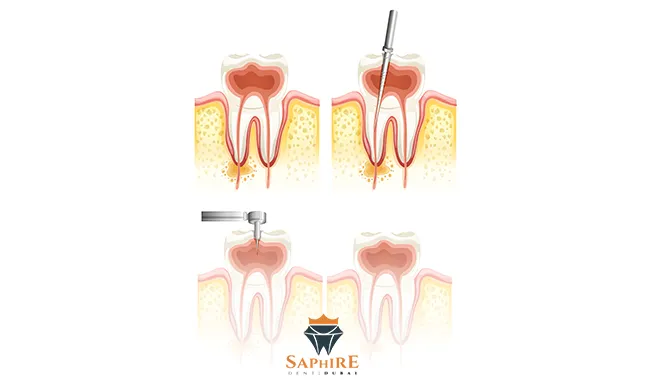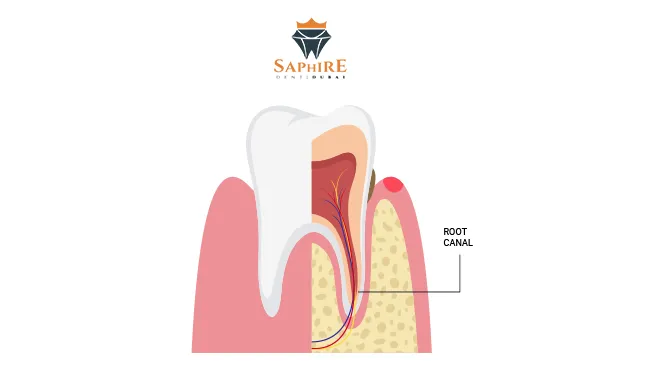How to treat root canal : Innovative techniques for easily relieving dental pain
Dental pain is often described as a severe experience for many, and among the worst pains someone can experience are nerve pains. Treating root canal often seems hard , but the truth is, there are simple and painless solutions that offer relief from dental pain. Here’s everything you need to know about treating root canal with effective methods.
1. Local Anesthesia Technique: The Perfect Start
One of the most important steps in the process of root canal is the use of local anesthesia technique. The specialized dentist applies a local anesthetic substance to the gum surrounding the affected tooth, significantly reducing pain. Because of the to technological advancements, this technique has become more effective and has less impactful on gum tissues.
2. Utilizing 3D Imaging Devices: accurate and full Control
It’s important for the dentist to have an accurate vision for diagnosis and treatment during the root canal process. Therefore, many dentists rely on using 3D imaging devices, which enable them to see the tooth structure clearly and pinpoint the location of the nerve with accuracy. This allows them to work more efficiently and provide an accurate and effective treatment.
3. Laser Technology: The Modern Solution for Pain Reduction
With the medical technology, it has become possible to utilize lasers in coot canal procedures. Laser use is an excellent option for pain reduction and minimizing recovery time after surgery. The laser creates a channel in the tooth to access the nerve with exceptional accuracy without causing harm to surrounding tissues.
4. Postoperative Care: Secrets to Rapid Healing
After root canal procedure, it’s important to carefully follow the doctor’s instructions to ensure rapid and proper healing. It’s important to avoid consuming hard and hot foods for some time, and to maintain good oral hygiene to prevent infections. Additionally, taking anti-inflammatory and pain-relieving medications as directed by the doctor is advised.
Customized root canal Treatments for Your Unique Case
Root canal is a simple dental procedure aimed at reducing pain caused by infected teeth. The treatment becomes necessary when gum bacteria invade the tooth. This typically occurs when a dental cavity is left untreated for an extended period or if the tooth is cracked or damaged.
We carefully assess your unique oral condition and create a suitable root canal treatment plan accordingly. This personalized approach is what enables us to deliver better and more sustainable results for your teeth through our root extraction treatments.

When is root canal treatment performed?
root canal is necessary when harmful bacteria infiltrate the central part of your tooth, often due to an untreated cavity or tooth injury.
Sometimes, you may not even realize that there’s a problem with your teeth that needs attention. Here are some signs that indicate you may need nerve extraction treatment:
- ألم الأسنان الدائم
- حساسية المشروبات الساخنة والباردة
- اللثة المنتفخة أو المتقيحة
- نتوء على اللثة
- فك منتفخ
- الأسنان التي تبدو غامقة اللون
- الألم عند اللمس أو المضغ
- سن مكسور

Types of nerve root canal treatments include:
- علاج سحب غير الجراحية
- استئصال قمة الرأس Apicectomy
- إجراء سحب العصب Gentlewave
- نظام Waterlase من Biolase
- إعادة معالجة العصب
- جراحة العصب المجهرية
The Steps of the root canal Procedure:
الخطوة الأولى
تحضير لعملية العصب
قبل العلاج، سيقوم طبيب أسنانك بأخذ صور بالأشعة السينية للأسنان المصابة. وهذا يسمح لهم ببناء صورة واضحة للعصب وتقييم مدى الضرر.
الخطوة الثانية
إزالة العصب
سيقوم طبيب أسنانك بعد ذلك بالوصول إلى الأنسجة الرخوة الموجودة في مركز السن لإزالة اللب المصاب. ويتم ذلك تحت التخدير الموضعي، وبالتالي فإن العملية غير مؤلمة.
الخطوة الثالثة
تنظيف وتعبئة لب السن
بمجرد أن يصبح لب السن جاف ونظيفًا تمامًا، سيستخدم طبيب أسنانك مادة تسمى جوتا بيركا (مادة تشبه المطاط) لملء القنوات. يتم تسخينه وضغطه ليتناسب مع الجدران.
الخطوة الأخيرة
إعادة بناء السن
بعد تنظيف وتعبئة قنوات الجذر، قد يقوم طبيب الأسنان بإعادة بناء السن المتضرر إذا كانت هناك حاجة لذلك. يمكن استخدام مواد مختلفة مثل التاج أو الحشوات لإعادة بناء السن واستعادة وظيفته الطبيعية ومظهره.
The Effects of Delaying Nerve Extraction Treatment
Delaying root canal treatment can have a negative impact on oral and dental health. If treatment is ignored for an extended period, the infection may worsen and affect surrounding tissues, leading to more significant problems such as facial swelling or the formation of abscesses.

Regular Follow-up
Regular check-ups with your dentist are important after treatment to ensure its success and to detect any new problems. Your dentist can monitor developments and respond to any issues that may arise, helping to maintain your overall oral health.
Consultation with a dentist
Don’t hesitate to consult a dentist if you’re experiencing any symptoms indicating a problem with any of your teeth. Early diagnosis and appropriate treatment can protect your teeth and prevent problems from worsening in the future.




